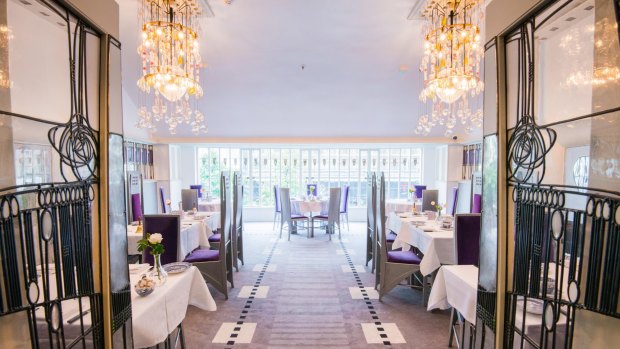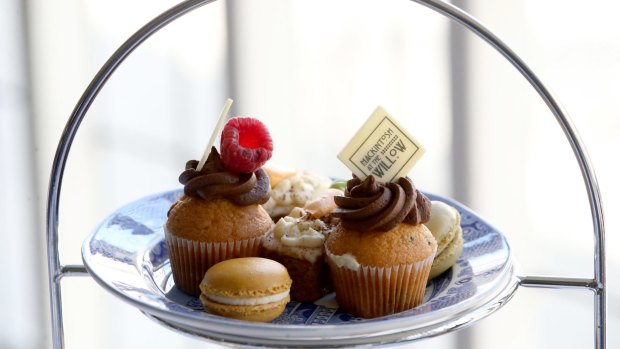This was published 3 years ago
Glasgow's Mackintosh tearooms: How they were rescued and restored to their former glory
By Katrina Lobley

Mackintosh at the Willow Tea Rooms and Museum, Glasgow.
Celia Sinclair is perched at her favourite table at Mackintosh at the Willow – the Charles Rennie Mackintosh-designed Glasgow tearooms she rescued because no one else would.
Sinclair could have installed herself in the theatrical Salon de Luxe – the first-floor jewel-box where it once cost an extra penny to sip a cup of tea surrounded by fairytale chandeliers, silvered chairs and mirrored walls, but it says everything about Sinclair that she prefers the low-key gallery – once likened to a "trellised rose bower" – above the tearooms' Back Saloon.
"It's lovely to sit here, to see people moving around and the light coming through, and to hear the chatter," says the businesswoman, clad in a neat jacket because she's "not a floral person – I like classics".

Cakes for tea at Mackintosh at the Willow.Credit: Jane Barlow / PA Images
That helps explain why Sinclair is such a fan of Glasgow architect, designer and artist Charles Rennie Mackintosh – today considered one of Scotland's most influential creatives after decades of near-obscurity.
Glasgow's tearoom queen Miss Kate Cranston was another fan. In 1903, she gave him free rein to design these tearooms, right down to the waitresses' pink bead chokers. His wife, artist Margaret Macdonald, helped design what was known as the Willow Tea Rooms. Now named Mackintosh at the Willow, it's become the world's finest complete Art Nouveau project, highlighting Mackintosh's mastery of spatial arrangements and his ability to design with light.
Sinclair and I met before COVID came along and before the tearooms launched a successful fundraiser in 2020 to help it survive the king-hit of the pandemic. Over a cup of Duchess Grey – "no milk, no sugar, just plenty of water" – Sinclair explains why she felt compelled to save the site when it went up for sale.
"I thought, 'We just can't let this happen' because we've lost so much heritage in Glasgow already and this is the last surviving Mackintosh tearoom," she says. "I spoke to all sorts of people to get interest to save the tearooms and, to cut a long story short, nobody was interested. It was in very poor state and had been all hacked about but thankfully a lot of the original features were still intact.
"I sat out there in Sauchiehall Street on a bench in May 2014 and thought, 'Celia, you're just like everybody else – you expect someone else to do it. Nobody else is going to do it so you have to do it'. It was a kind of eureka moment. I thought, 'I'm a madwoman'. My background is commercial property and business so I knew it would be pretty difficult."
She convinced the vendor to sell her the building, transferring it to a trust that today operates the tearooms as a charity and social enterprise offering young people training and employment. "I issued a press release at midnight on the day of settlement that the tearooms had been purchased," says Sinclair, today the founder patron of the Willow Tea Rooms Trust. "I was coming in at 10am the next day to take a few photos to commemorate the day and I couldn't get in through the door because the whole press pack of Scotland had turned up. It was so exciting because I thought, 'People do care'."
All that interest helped buy the neighbouring building to house a visitor centre. Artisans were commissioned to restore the tearooms to their former glory. Stained-glass artist and conservator, Linda Cannon, was among those who launched into detective mode to re-create the tearooms' original look. One puzzle for Cannon was working out the colours of the bubbled glass droplets in the Salon de Luxe's statement chandeliers that one customer remembered as grape-coloured. Eventually, it dawned they were green, pink and clear glass shapes.
"Everything began to piece together and we could see that, yes, they were pink and green grapes," she says.
Cannon also took up knitting to "figure out how all the copper wire wrapped around the balls so they could safely hang and look good as well".
Her only wish now is for dimmer lighting, after seeing the effects of low wattage during installation. "It was incredible – you could see the shadows on the white paintwork," she says. "It was like the chandelier strings and wires became tree bark and tree stumps – all sorts of tree creations were happening from the shadows in the room. We're playing with light the whole time so you have to understand how light works. Glass isn't a dead material – it dances, it's alive, it's warm and sensual."
Four years after Sinclair's light-bulb moment and some £10 million ($17.5 million) later, the meticulously restored tearooms opened in mid-2018.
However, the big moment was overshadowed when the nearby Glasgow School of Art's Mackintosh Building, named after its visionary architect, was destroyed by a fire while rebuilding after a 2018 blaze. The bad news was enough to make Mackintosh lovers weep.
Some consolation were the tearooms, which channel a glamorous bygone era brimming with the Edwardian spirit of enjoyment. "Glasgow was grimy and sooty at that time and then you walk into this fairyland of colour and light," says Sinclair. "Look at the chandeliers in the Salon de Luxe – what went on in his head?"
Against the background of the Temperance movement, tearooms were respectable because they didn't serve alcohol. Restrooms also allowed women to be away from home longer. "It was the start of a social revolution," says Sinclair. The pioneering Cranston opened her first Glasgow tearoom in 1878, eventually owning four that provided work for young women.
The more I learn about Sinclair and Cranston, the more alike they seem. What does Sinclair think of the tearoom entrepreneur? "I sometimes feel I know her awfully well – I think we're quite like-minded," she says. "She was somebody where things had to be right – there was attention to detail, staff training and running a very good and successful business with a social conscience. I would say I'm a Scottish capitalist with a social conscience."
Cranston became more widely known in 2020 when her face adorned Scotland's first polymer £20 notes. When the Royal Bank of Scotland's Malcolm Buchanan made the announcement at the tearooms, he said: "Kate Cranston's legacy touches so many aspects of Scottish life that we, as a nation, are justifiably proud: entrepreneurialism, art, philanthropy and dedication. Choosing the design of the £20 note was an important decision for it is Royal Bank of Scotland's biggest circulating note."
One of these notes is enough for you and a friend to sit in the tearooms, ring a hand bell for service, and sip tea from willow-pattern crockery while nibbling scones with jam and clotted cream. For afternoon teas served with whisky, gin, bubbles or a cocktail, you'll need to dig a little deeper.
THE DETAILS
VISIT
Bookings are recommended for the main Mackintosh at the Willow tearooms, which offer pastries, lunch and themed afternoon teas (from £24/$A45 a person). Champagne afternoon tea in the Salon de Luxe, including a talk and exhibition access, costs £45 a person (or £39 without alcohol). The tearooms also have a south-facing terrace and a street café. Book a tour (daily at 10am and 11am, £7.50 a person) and explore the in-house exhibition (£5.50 or £10 combined with tour). 215-217 Sauchiehall Street, Glasgow. See mackintoshatthewillow.com
STAY
Native Glasgow, a 64-apartment hotel near George Square in central Glasgow, opened in 2018 within a building of similar vintage to the tearooms. The 1906 Edwardian property once housed the Anchor Line Shipping Company. Rooms from £87. See nativeplaces.com
MORE
Katrina Lobley was a guest of Mackintosh at the Willow and Glasgow Life, see peoplemakeglasgow.com
FOLLOW THE MACKINTOSH TRAIL
KELVINGROVE
The imposing art gallery and museum, built two years before the Willow Tea Rooms, houses Mackintosh and the Glasgow Style Gallery – the largest permanent display of works from the movement's key figures. Admire tearoom interiors, furniture, ceramics and stained glass. BYO mask. See glasgowmuseums.com
THE LIGHTHOUSE
The Mackintosh Interpretation Centre – or the Mack Centre – is on the third floor of The Lighthouse, Scotland's Centre for Design and Architecture that's housed in a Mackintosh-designed building. A helical staircase leads to the Mackintosh Tower offering outstanding views over central Glasgow. The Lighthouse is temporarily closed. See thelighthouse.co.uk
CHEERS, TOSHIE
Savour a pint with Mackintosh at Glasgow's The Clutha Bar where a mural of the architectural visionary - the handiwork of street artist Rogue-one - looms over the ruins of the beer garden (a police helicopter crashed into the pub in 2013, killing 10 people). No website, see The Clutha Bar at Facebook
THE OAK ROOM
The Oak Room, once part of Miss Cranston's Ingram Street Tearooms, was stored in pieces for decades before a conservation team reassembled the three-dimensional jigsaw for display at Scotland's V&A Dundee as part of the Scottish Design Galleries. See vam.ac.uk/dundee.
78 DERNGATE
In 1916-17, in what was Mackintosh's final major commission, he remodelled the interior and exterior of 78 Derngate – a brick terrace in Northampton, 107km north-west of London. Poke around the house on a self-guided tour. See 78derngate.org.uk
Sign up for the Traveller Deals newsletter
Get exclusive travel deals delivered straight to your inbox. Sign up now.